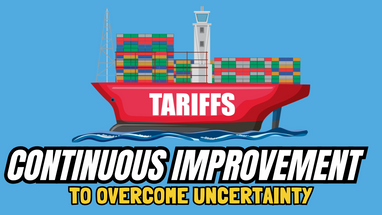Apr 7th 2025
How Continuous Improvement in Manufacturing Increases Flexibility and Buffers Against Uncertainty
In a volatile global economy, uncertainty is fast becomeing the new normal. Whether it’s fluctuating demand, supply chain disruptions, labor shortages, or geopolitical instability, manufacturers are constantly being tested. The organizations that thrive are not necessarily the largest or most well-funded—they are the most adaptable. One of the most effective ways manufacturers build adaptability is through a culture of continuous improvement (CI).
What Is Continuous Improvement?
At its core, continuous improvement is a mindset and methodology focused on small, ongoing changes that enhance processes, reduce waste, and increase value. It’s often associated with lean manufacturing, Six Sigma, Kaizen, and other structured frameworks. But beyond the tools and terminology, continuous improvement is about cultivating a culture where every employee, at every level, looks for ways to do things better every day.
Flexibility Through Process Agility
Manufacturing flexibility means being able to adjust quickly to new requirements, whether that’s a change in customer demand, product customization, or regulatory updates. CI promotes process agility by:
- Standardizing work: When processes are documented and optimized, it's easier to tweak them without causing disruption.
- Eliminating waste: By continuously removing inefficiencies, manufacturers free up time and resources that can be reallocated to new priorities. Complete an Audit to Decrease Inefficiencies for a personalized summary of potential cost and lead time reductions, recommended action items, and a detailed analysis listing each area of potential improvement by line item.
- Empowering workers: CI encourages frontline employees to spot problems and implement solutions quickly, allowing for faster response to changes.
- Enabling modularity: Improvements often lead to more modular and scalable processes that can adapt to different products or volumes with minimal downtime.
Automation as a Continuous Improvement Catalyst
Modern CI initiatives increasingly include emerging automation technologies—particularly collaborative robots (cobots)—as key enablers of flexibility and resilience. Unlike traditional industrial robots, cobots are designed to work safely alongside human workers and can be quickly reprogrammed and redeployed.
By integrating cobots into continuous improvement strategies, manufacturers gain:
- Faster implementation of process changes due to cobots' ease of programming and redeployment.
- Increased consistency and quality, reducing the variability that often undermines agility.
- Support for labor-strapped operations, allowing companies to do more with fewer workers.
- Lower barriers to automation, enabling even small or mid-sized manufacturers to remain competitive and responsive.
Whether it’s automating repetitive tasks or handling dangerous materials, cobots help create a more agile and scalable workforce, aligned with the principles of continuous improvement.
Preparing for Tariff Increases and Cost Volatility
Trade policies can shift quickly, often leading to sudden increases in tariffs and input costs. Manufacturers with a robust CI program are better prepared to manage these impacts because they’re already focused on reducing waste and increasing efficiency. Continuous improvement helps by:
- Improving cost visibility through better data tracking and process transparency, making it easier to identify areas for cost-saving.
- Optimizing supplier networks and enabling quicker transitions to local or alternative sourcing when tariffs make overseas suppliers less viable.
- Reducing dependency on high-tariff materials by encouraging design-for-manufacturability practices that lower cost and complexity.
- Speeding up process reconfigurations to accommodate new materials, components, or workflows without prolonged downtime or quality loss.
By embedding agility into the operation, continuous improvement becomes a proactive defense against unpredictable cost increases—ensuring manufacturers stay competitive even when external costs rise.
Building a Buffer Against the Unexpected
Uncertainty can’t be eliminated—but its impact can be minimized. Continuous improvement helps manufacturers build resilience in several key ways:
- More robust processes: Regular improvements make systems less fragile and better able to absorb shocks.
- Shorter lead times: As processes become leaner and more efficient, manufacturers can react more quickly to changes in demand or supply.
- Data-driven decisions: CI initiatives often involve rigorous tracking of KPIs and root cause analysis, helping teams make better, faster decisions when the unexpected occurs.
- Cross-trained teams: A culture of continuous improvement usually includes upskilling workers, which creates a more flexible workforce capable of pivoting as needed.
Real-World Examples
- Automotive suppliers that embrace CI are able to switch production lines more easily to meet changing OEM schedules.
- Medical device manufacturers with lean, continuously improving operations can rapidly ramp up or modify production to meet new regulations or emerging health crises.
- Electronics producers that adopt CI methodologies are better positioned to redesign workflows when a key component becomes unavailable—or when tariffs force a sudden change in sourcing strategy.
The Bottom Line
Continuous improvement isn’t just about efficiency—it’s a strategic advantage in uncertain times. It equips manufacturers with the tools, mindset, and agility to not only survive disruptions but also capitalize on new opportunities. In an era where change is constant, the most reliable defense is a culture that embraces it—supported by automation, adaptable processes, and a readiness to respond to everything from supply chain shocks to tariff hikes. Complete our Audit to Decrease Inefficiencies now to prepare for the unexpected.

